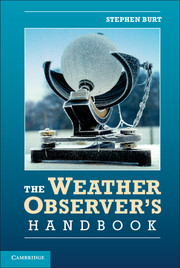Book contents
- Frontmatter
- Contents
- Acknowledgements
- Abbreviations, footnotes and references
- Part One The basics
- Part Two Measuring the weather
- Part Three Making the most of your observations
- 17 Collecting and storing data
- 18 Making sense of the data avalanche
- 19 Sharing your observations
- 20 Summary and getting started
- Appendix 1 Metrology and meteorology: The basics of instrument theory
- Appendix 2 Useful functions
- Appendix 3 Unit conversions
- Appendix 4 Useful sources
- Index
- References
18 - Making sense of the data avalanche
Published online by Cambridge University Press: 05 July 2012
- Frontmatter
- Contents
- Acknowledgements
- Abbreviations, footnotes and references
- Part One The basics
- Part Two Measuring the weather
- Part Three Making the most of your observations
- 17 Collecting and storing data
- 18 Making sense of the data avalanche
- 19 Sharing your observations
- 20 Summary and getting started
- Appendix 1 Metrology and meteorology: The basics of instrument theory
- Appendix 2 Useful functions
- Appendix 3 Unit conversions
- Appendix 4 Useful sources
- Index
- References
Summary
For the majority of observers collecting weather measurements is a means to an end, rather than an end in itself, because making good use of the records obtained is ultimately more rewarding still. Records build rapidly into useful datasets, particularly from AWSs, and even a few months worth of data can provide fascinating and sometimes unexpected insights into local weather patterns. Current records can be combined or compared with historical and local digital climate information from national records, which are freely available online in many countries. Modern spreadsheet software provides a wide variety of sophisticated, yet easy-to use, graphical and statistical analysis tools which allow the potential of the records to be much more quickly and easily realized than when held in manuscript form.
This chapter builds upon the suggested ways of collecting and storing data outlined in the previous chapter, to show how quickly and easily presentation-quality graphics and sophisticated statistical analyses of meteorological records can be generated using everyday software. (A reasonable working knowledge of spreadsheets has been assumed, as it is beyond the scope of this book to attempt to provide detailed software tuition.) Numerous examples are presented to aid understanding and provide a starting point for those with more limited spreadsheet literacy: there are also many excellent book and video-based tutorials available for all software literacy levels. Readers are encouraged to use these ideas and concepts to develop their own projects using their own observational records. Practice quickly builds into expertise.
Most examples use Microsoft Excel 2007 or 2010, the industry standard spreadsheet, and the examples given here relate to the PC/Windows commands. While the detailed functions may be different in other packages, the principles outlined in this chapter remain broadly similar whichever software is in use.
- Type
- Chapter
- Information
- The Weather Observer's Handbook , pp. 348 - 377Publisher: Cambridge University PressPrint publication year: 2012



